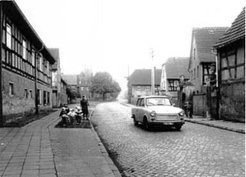Political Economy and Political Clientelism in the Agricultural and Industrial Region South of Leipzig
Political Economy and Political Clientelism in the Agricultural and Industrial Region South of Leipzig
Two Turning Points: 1945 and 1990

of Breunsdorf in the socialist era.
After 1945 the further development of agriculture and industry was determined by the policies of the Soviet occupational administration and, beginning in 1949, of the German Democratic Republic. One of the first orders of business was the nationalization of the carbo-chemical industries and the aggressive exploitation of coal resources - Eastern Germany lacks other fossil fuels. The first phase of the new agricultural policy involved the break-up of large farms and the distribution of land to many smallholders in the land reform of 1945. Then came the collectivization of farming enterprises, beginning in the mid-1950s, and the industrialization of agricultural production in the 1970s and 1980s.
After 1990 - a year which saw the dissolution of the socialist government, the incorporation of the East German states into the Federal Republic of Germany, and the opening of the East German economy to the global market - heavy industry in the Southern Region of Leipzig collapsed. Within a short period of time, tens of thousands of jobs were lost, and even after massive new investment the workforce in the mining, energy, and chemical industries was reduced to a fraction of its former capacity. Simultaneously, new laws required the privatization of agricultural production and the restructuring or dissolution of the collective farms of the socialist era. Many of the collective farms have survived the restructuring process in the form of agricultural cooperatives or corporations; but in these cases as well the workforce has often been reduced by more than ninety percent. Since 1990, a number of family farms and larger private agricultural enterprises have been established or re-established, but this has involved only a small percentage of the local farming families and returning West Germans. Many of the former workers in industry and agriculture went into early retirement, some found new occupations or were integrated into make-work programs, and many others entered the ranks of the unemployed. Workers in the carbo-chemical branch, however, have received relatively favorable pensions, while the landowners among the collectivized farmers receive some income - usually a very modest amount - by leasing their land to ongoing agricultural enterprises. Today, the region is characterized by high unemployment, out-migration, and an aging population.
While agriculture and the carbo-chemical industries now offer relatively few jobs, they do provide a significant tax base for the county and its communes. Tax revenues have been supplemented by state funding and by compensatory payments which industries have made to various landowners, including the communes. The result has been a dramatic improvement in the regional infrastructure, which, however, also entails rising costs for residents. The future of the region depends largely on the further development of the city of Leipzig. Since it is widely recognized that the industrial jobs of the socialist era will never be replaced, planners are now seeking to develop the Southern Region as a suburban recreational area, especially by flooding the former surface mines and, in this way, creating a series of lakes.
Aspects of Property Relations in the Southern Region of Leipzig
Against this backdrop, the project focuses on the following aspects of property relations: land, employment and entitlements, housing and public utilities, and citizenship.
